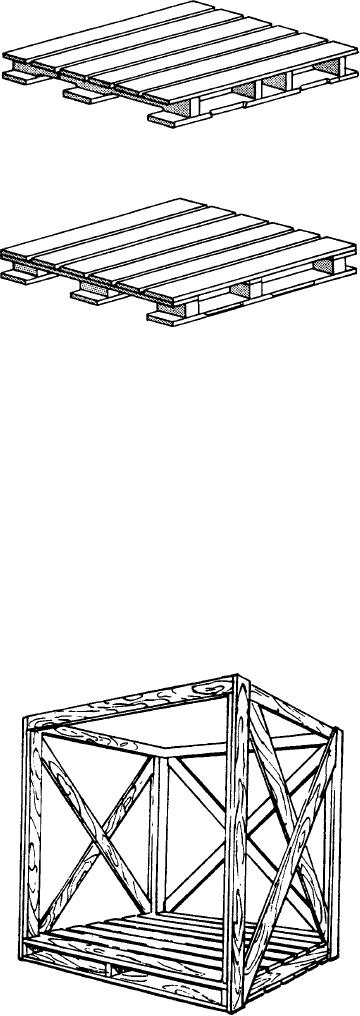
them sanitary. Lightweight aluminum pallets also are
used, but are expensive and difficult to repair.
Loading Pallets
When a pallet is loaded, three things must be
considered: (1) maximum load, (2) stability, and (3)
A
proper pallet size. The pallet must pass through all
doors, aisles, and hatches likely to be encountered. The
stability of the material on the pallet must be
considered and a decision made as to the type of pallet
to use.
Figure 7-15 shows the recommended way to load
material on a pallet. The size of the boxes being loaded
will determine their arrangement on the pallet. A
standard loading pattern is not always appropriate.
However, in the illustration you can see that the
B
SKf07013
material not only fits the pallet, as recommended in A
Figure 7-13.--Pallet, 40 x 48 inches, four-way entry: (View A)
and B stacking, but is arranged so as to provide stability
Partial stringers (View B) post construction.
against slipping or sliding.
Boxes of materials are not always the same size.
bottom of the stringers and is excellent for stevedoring
When this is true, place the highest and strongest cases
and transit-shed operations.
at each end of the pallet and the smaller and more fragile
cases in the center. This arrangement provides a
The box-type pallet, illustrated in figure 7-14, is
stronger surface for a second tier of eases on the pallet
used for handling small-lot items or easily crushed
and also makes it possible to place a second loaded
cargo. When discharging items from a ship to a transit
pallet on top for storage.
s h e d , l o a d i n g d i r e c t l y i n t o a b o x p a l l e t s ave s
considerable time and labor.
When you palletize round items, such as gas
cylinders, use specially constructed notched spacers or
Sheet metal pallets are convenient for three
collars as shown in figure 7-16.
reasons (1) the maintenance cost is low, (2) they save
storage space, and (3) you have no problem keeping
Palletized material that must be moved several
times should be strapped. Metal or nylon strapping may
be used; the number of straps required for a palletized
unit depends upon the kind of handling it is to receive.
The tool used to tighten the strapping is capable of
exerting a great amount of force. Therefore you must be
careful not to crush the material. Metal or folded
cardboard corners may be placed under the strapping to
distribute the force over a wider area and help prevent
damage to the cartons or their contents.
DRUM-HANDLING EQUIPMENT
The drum-handling sling is a device for picking up
drums or barrels. It was designed for shipboard loading,
but may be used with a crane for any drum or barrel
handling operation. The sling may be of the chain type
(figure 7-17, View A), which is a series of chain loops
and sliding hooks. It may also be of the frame type,
SKf07014
Figure 7-14.--Box pallet.
7-6

